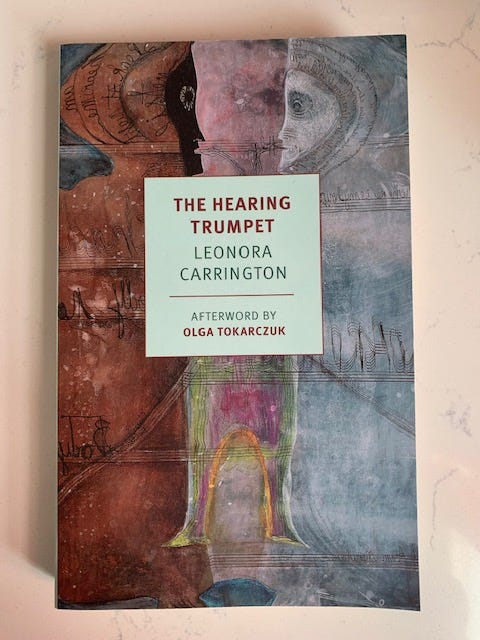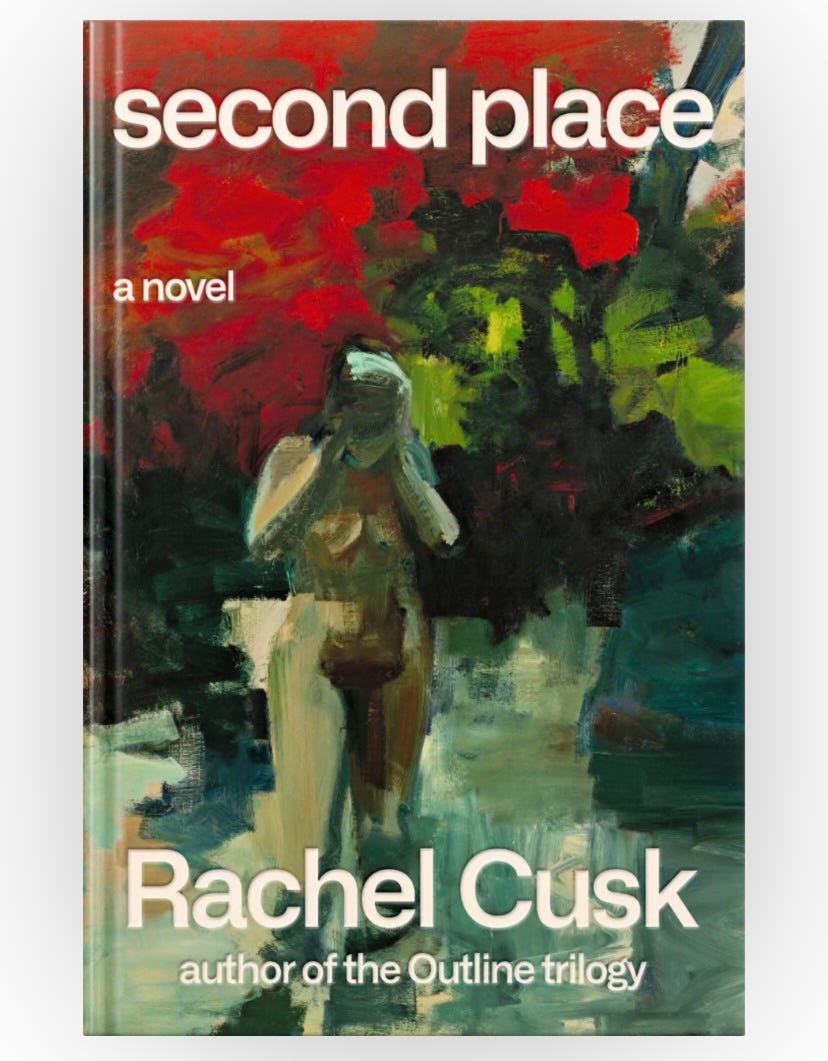Shoutout to all the moms out there! Hope you’re having a great day! I didn’t plan to pair Leonora Carrington’s eccentric novel with Mother’s Day, but lucky for me it’s relevant. I heard some buzz about the release of this new edition from The New York Review of Books a few months back, but I hadn’t heard of Carrington, so I didn’t think much of it. It wasn’t until I was at the Strand and saw it had an afterword from Olga Tokarczuk and a blurb from Bjork that I was like:

Here’s the cover:
If you enjoy this review, click the ♥️ above or
New here?
According to her bio page in this edition, Leonora Carrington was born in Lancashire, England, in 1917, and grew up at her family’s estate called Crookhey Hall. She was expelled from two convent schools before attending art school in Florence. She eventually landed in London, where she became a part of the Surrealist art movement. She also met Max Ernst, who was married at the time, and they lived together in France before World War II. Carrington would eventually live and create art in Mexico City. It’s clear that her time among the Surrealists influenced her writing. To paraphrase Tokarczuk, ‘The Hearing Trumpet’ is as surreal as a Hieronymus Bosch painting. At the end of this newsletter, I expect you’ll be like:

But it’s worth it. The novel opens with 92-year-old protagonist Marian Leatherby living with her son’s family somewhere in Mexico. Marian has no teeth and is mostly deaf, able to hear only when shouted at. A friend gives her a hearing trumpet as a gift, allowing her to overhear her family’s plan to put her in an old-folks home. The facility is run by a two-person religious cult, and the elderly women who live there are instructed to partake in spiritual self-improvement ‘Work’ involving bizarre exercises where they pat their heads and rub their stomachs. Each resident is assigned a bungalow. Marian’s is shaped like a lighthouse. Others look like a boot and a toadstool. In her living quarters are images of furniture painted on the walls rather than actual items. This GIF doesn’t quite capture it, but it’s the closest I could find:

In their common dining room hangs a painting of a nun who seems to be winking. Marian puzzles over the image, wondering who the ‘Winking Abbess’ could be and what her expression could mean. Marian dreams up a name for the nun: ‘Doña Rosalinda Alvarez Cruz della Cueva from El Convento de Santa Barbara de Tartarus.’ Later, she receives a book about the nun and learns her invented name was accurate. She also learns that Doña Rosalinda lived centuries ago and that her strange backstory involved swordplay, murder, cross-dressing, magical potions, the Knights Templar and the Holy Grail. These revelations lead to out-of-season snowfall, earthquakes, unnatural bee behaviors, the appearance of a mythical creature, the opening of a gateway to hell and the arrival of a wolf-headed woman. It’s as if these cataclysmic events were set in motion by the nun in the painting, like:
But the strangest thing is that despite all the unpredictable twists and turns, this novel totally worked for me. I love how Carrington constructs the story in a way that makes all the crazy happenings feel logical and advance the story. I love that the novel is illustrated by drawings from Carrington’s son, keeping with the spirit of Mother’s Day. And lastly, I love her message: Older women still can have adventures and be involved in world-significant events, even if society or their own families would prefer to hide them way or pretend they don’t exist. I understand this book might not be for every reader, but I couldn’t put it down. Each page was a delight, and I urge you to give it a chance.
How it begins:
When Carmella gave me the present of a hearing trumpet she may have foreseen some of the consequences. Carmella is not what I would call malicious, she just happens to have a curious sense of humour. The trumpet was certainly a fine specimen of its kind, without being really modern. It was, however, exceptionally pretty, being encrusted with silver and mother o’pearl motives and grandly curved like a buffalo’s horn. The aesthetic presence of this object was not its only quality, the hearing trumpet magnified sound to such a degree that ordinary conversation became quiet audible even to my ears.
Here I must say that all my senses are by no means impaired by age. My sight is still excellent although I use spectacles for reading, when I read, which I practically never do. True, rheumatics have bent my skeleton somewhat. This does not prevent me from taking a walk in clement weather and sweeping my room once a week, on Thursday, a form of exercise which is both useful and edifying. Here I may add that I consider that I am still a useful member of society and I believe still capable of being pleasant and amusing when the occasion seems fit. The fact that I have no teeth and never could wear dentures does not in any way discomfort me, I don’t have to bite anybody and there are all sorts of soft edible foods easy to procure and digestible to the stomach. Mashed vegetables, chocolate and bread dipped in warm water make the base of my simple diet. I never eat meat as I think it is wrong to deprive animals of their life when they are so difficult to chew anyway.
I am now ninety-two and for some fifteen years I have lived with my son and his family. Our house is situated in a residential district and would be described in England as a semi-detached villa with a small garden. I don’t know what they call it here but probably some Spanish equivalent of “spacious residence with park.” This is untrue, the house is not spacious, it is cramped, there is nothing resembling even faintly a park. There is, however, a fine back yard which I share with my two cats, a hen, the maid and her two children, some flies and a cactus plant called maguey.
My rating:
‘The Hearing Trumpet’ by Leonora Carrington was originally published in a French translation as ‘Le Cornet acoustique’ by Flammarion in 1974. It was published in English in the U.S. by St. Martin’s Press in 1976. The New York Review of Books Classics edition, with a new afterword by Olga Tokarczuk, was published in 2020. 210 pages (including afterword). $15.95 from The New York York Review of Books.
Disagree with my review? Let me know:
Connect: Twitter | Instagram | Goodreads | Email
Before you go:
ICYMI: Review #158 featured ‘Interior Chinatown’ by Charles Yu. Also, yesterday was our fifth anniversary. | Browse the Archive
Read this: I was really excited to read an interview with The Roots’s Black Thought, one of my favorite rap artists, in The Paris Review. This Q&A touches on a lot of subjects, but I was really interested to get his thoughts on writing, dealing with writer’s block and even learning about his favorite pen brand.
Do this: Jhumpa Lahiri talks about her first novel in a decade, ‘Whereabouts,’ at a virtual event with Maaza Mengiste on Weds., May 19, at 8:30 p.m. ET. Tickets are $35-$55. More information can be found here. Lahiri translated her novel from the Italian into English. Longtime Books on GIF readers may remember we reviewed her translations of Domenico Starnone’s ‘Trick’ and ‘Ties.’
Do this, too: You are all invited to Books on GIF’s second-ever virtual event. If you’re free Saturday, May 15, at 3 p.m. ET, we would love to see you. It’s going to be another show-and-tell: Let’s share books we’re looking forward to reading this summer. (If you don’t want to share, but still want to attend, no worries!) To RSVP, email us at booksongif@gmail.com to get the link and passcode.
Thanks for reading, and thanks especially to Donna for editing this newsletter!
Until next time,

MPV










That Van Gogh GIF is amazing! And once again, thank you to Books On Gif for writing about odd little books I would never know about if not for BoG. Here’s to taking a chance on a book and finding new pleasures. Thank you.